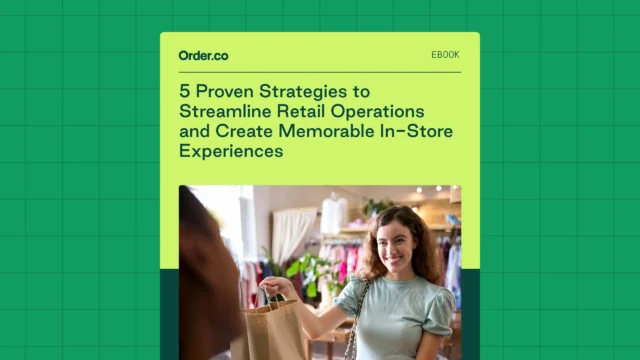How Retail Management Software Solves Modern Procurement Challenges

How Retail Management Software Solves Modern Procurement Challenges
We’ll just say it: The retail landscape of 2025 is giving retail brand managers and in-store management teams a run for their money when it comes to agility and contingency planning. Ongoing concerns around supply chain management and tariff impacts are pushing retailers to become more resourceful and data-driven in their approach to sourcing and promoting products.
While these complexities may be adding more hours to the workday, they also present an opportunity to improve processes and enhance customer loyalty. Building a stronger retail management strategy not only helps brands get through tough times—it can also bolster performance long after the retail market regains its footing.
Technology is one of the best bets for retailers of all sizes to gain visibility and agility. With the right platforms in place, retail managers and procurement teams can see more of what’s working and tailor their approach to increase customer satisfaction while maintaining healthy margins.
This article explores the tools and tactics that can help retailers achieve better results and remain flexible in the face of change.
Top challenges of retail management
Retailers tend to confront universal hurdles in managing their locations. Inventory control, customer satisfaction, staffing issues, and changing market trends all influence how they adapt. These five areas are most often top of mind for retail managers trying to keep products flowing from vendors to customers.
Inventory management: Balancing stock levels against spending is an important but sometimes tricky component of retail success. Carrying too much stock increases the risk of waste through stale product. Using retail inventory management to find appropriate inventory levels ensures you have what you need to meet customer demand without excess.
Cost efficiency: While well-managed retail margins can vary significantly (from as low as 2–10% to as high as 22–34%, depending on category and strategy), controlling inventory and operational costs remains one of the most effective ways to improve them. Sourcing high-quality, competitively priced products from trusted vendors is a smart strategy for achieving your margin goals.
Adapting to customer trends: Consumer needs and desires are constantly evolving, so retail brands must keep their strategies fresh and flexible. Responding to trends also means maintaining a short product turnover cycle to prevent stale product from taking up shelf space.
Supply chain management: Given the reality of shipping constraints and new tariffs, strategy is more vital than ever. Retailers must balance supply with demand, reduce third-party risk, and keep costs aligned with profitability. Access to a flexible retail supply chain system that can help you overcome supply chain constraints is essential.
Retail operations management: Retailers must coordinate staffing, inventory control, sales forecasting, and customer service to keep stores running smoothly. Technology can help you establish more efficient processes and analyze customer data to increase sales and drive better results.
What are the 5 Ps of retail management?
The 5 Ps of retail management are a framework for success in a competitive consumer landscape. Think of them as the core principles that address the most important retail business needs.
- Product: The basis of any retail business is what you sell and how you meet your customers’ needs. Focus on quality, variety, and innovation in your product offerings to increase your likelihood of success.
- Price: Set competitive prices without sacrificing quality to further differentiate your offering and attract the right buyers.
- Place: Make sure your products are in the right location and platform to get noticed, whether through advantageous shelving in physical retail stores or proper placement in ecommerce channels.
- Promotion: Leverage effective advertising, sales promotions, social media marketing, loyalty programs, and public relations activities to capture attention, build interest, and persuade consumers to make a purchase.
- People: In-store employees are the first purveyors of your brand culture, giving customers a pleasant shopping experience while managing their expectations. Provide training, incentives, and advancement opportunities to help staff create better customer experiences and long-term brand success.
Key features in modern retail management software
Beginning the search for a new retail management or procurement management tool? Consider these key features common to top-performing options.
Procurement automation
Centralized procurement allows retailers to create purchase orders, track shipments, and manage invoices. A software system can automate many of the most tedious aspects of procurement to create accurate and time-efficient in-store operations with fewer errors and better experiences for retailers and consumers alike.
Analytics and sales reporting
Data should be the guiding force in decision-making for a retail brand. Procurement software empowers data-driven decisions through a centralized reporting dashboard that provides spend management insights by vendor, category, or location. Order.co offers a full suite of reporting and reconciliation tools to help you understand your spending, manage your budgets, and close your books.
Multi-store support
For retail chains with multiple locations, procurement and retail managers need features that scale. Centralized purchasing, reporting, and accounting make it easier to maintain supply levels and curate a consistent customer experience across every store or online outlet. Order.co’s centralized retail procurement tools help you orchestrate operations at scale—while still giving individual locations the freedom to place orders and find the best prices for goods.
Inventory management
An effective inventory management process helps retail managers track stock levels, refine order quantities, manage replenishment, and prevent overstock or stockouts to keep operations steady and customer engagement high.
However, not every retail business wants a granular, automated inventory management system. Many simply need a retail solution that makes it easy to get the right items at the right price and time. A procurement platform like Order.co offers a balance of product accessibility and user-friendly purchasing features. Front-line employees can order what they need, and advanced features like curated product catalogs and dynamic purchase controls ensure purchases stay within policy.
Faherty Brand uses Order.co’s curated catalogs, AI sourcing, and spend management tools to overcome retail management challenges and quickly expand into new locations. Read our customer case study to learn more.
5 steps to select and implement retail management software
A well-defined selection process is the best way to choose software of any kind. Use these steps as a framework to simplify decision-making and ensure a smooth rollout of your chosen software solution.
1. Define core objectives
To find the best-fit tool for your online store or brick-and-mortar location, start by clarifying your goals. Pinpoint the business case for moving to retail management software, whether improving order accuracy, simplifying procurement, integrating systems, or achieving other operational objectives. Taking the time to align your search with specific desired outcomes will help you evaluate your options with a clear focus on results.
2. Assess budget and ROI
When retailers turn to technology to improve the procurement process, the return on investment should far outshine the cost of implementation. Establish a preliminary budget for the new system, considering not just subscription cost but also functionality and long-term ROI.
Ask yourself: How much will my team save in spend, logistics, and manual labor costs versus the investment in technology, migration, and personnel training? The right platform often pays for itself in savings and operational improvements.
Using a cost-benefit analysis framework can help your team compare shortlisted options from a quantitative angle, factoring in both immediate costs and long-term financial benefits to make a more informed decision.
3. Plan data migration carefully
Clean data is at the heart of any successful data platform migration. Getting a handle on your current data streams will make migration smoother and deliver better retail and spend management results. A strong platform makes it easy to centralize data from every source into an accurate, accessible system that aids planning and analysis.
Audit: Conduct a thorough audit of all existing data. Identify what you have, where it resides, and its current format to ensure you don't overlook any critical information during the migration process.
Cleanse: Remove duplicates, fix errors, and standardize formats to verify the accuracy and reliability of data.
Define structure: Decide how the data will be organized, including tables, fields, and relationships, to ensure the migrated data works within the system.
Develop a plan: Create a step-by-step plan for how data will move.
Test migration: Conduct a test migration with a subset of your data to catch and correct issues before full migration.
Order.co makes data migration fast and easy by centralizing vendor info from your current systems. The platform also manages new data creation, including coding purchases with the correct GL codes for accurate financial tracking.
4. Check vendor and system integrations
Retail management systems are rarely standalone tools. Instead, they need to work within your larger tech stack to provide real-time information, reduce process redundancies, and provide a comprehensive view of your procurement activities.
When evaluating systems, look for a platform that integrates with the tools you already use. It should offer vendor-agnostic access to the products you need and readily share information with management systems, accounting software, enterprise resource planning (ERP) platforms, customer relationship management (CRM) systems, and product information management (PIM) tools. Order.co integrates with many of the top accounting and work management tools, including Sage Intacct, QuickBooks, NetSuite, and Workday.
5. Provide training to teams
Even the most sophisticated retail management system only works if employees are willing to use it, meaning comprehensive training and ongoing support are essential for adoption. Offering a strong onboarding process in multiple formats, such as in-person sessions, on-demand resources, and a support contact, helps empower staff to ensure implementation success.
Explore Order.co's retail management solution
Order.co gives retailers an alternative to traditional inventory management systems. The dynamic procurement platform provides flexible features to support your most important management activities, including AI-enhanced product sourcing, purchase order management, order tracking, and cost control. It even has comprehensive reporting and analysis tools to help you understand spending trends and manage the impact of supply costs on the bottom line.
Order.co helps you simplify purchasing and maintain flexibility and control across all your locations with:
- A vendor-agnostic approach that allows you to create a curated catalog of items from suppliers you already trust, plus sourcing access to more than 15,000 additional high-quality options
- Automated approval processes and dynamic workflows for every procurement activity that give all your locations the freedom to buy while maintaining full spend visibility and control
- Cutting-edge AI features to help your buyers find the best prices for products as well as options for out-of-stock items—the system even learns and improves as you use it
- Smart checkout stock visibility so buyers can select products with confidence, knowing the items they need will be in stock before they add them to the cart
To see Order.co in action and explore how it can help all your retail locations maintain balanced inventory levels while giving them the freedom to buy what they need, schedule a demo of Order.co today.
Get started
Schedule a demo to see how Order.co can simplify buying for your business.
"*" indicates required fields



